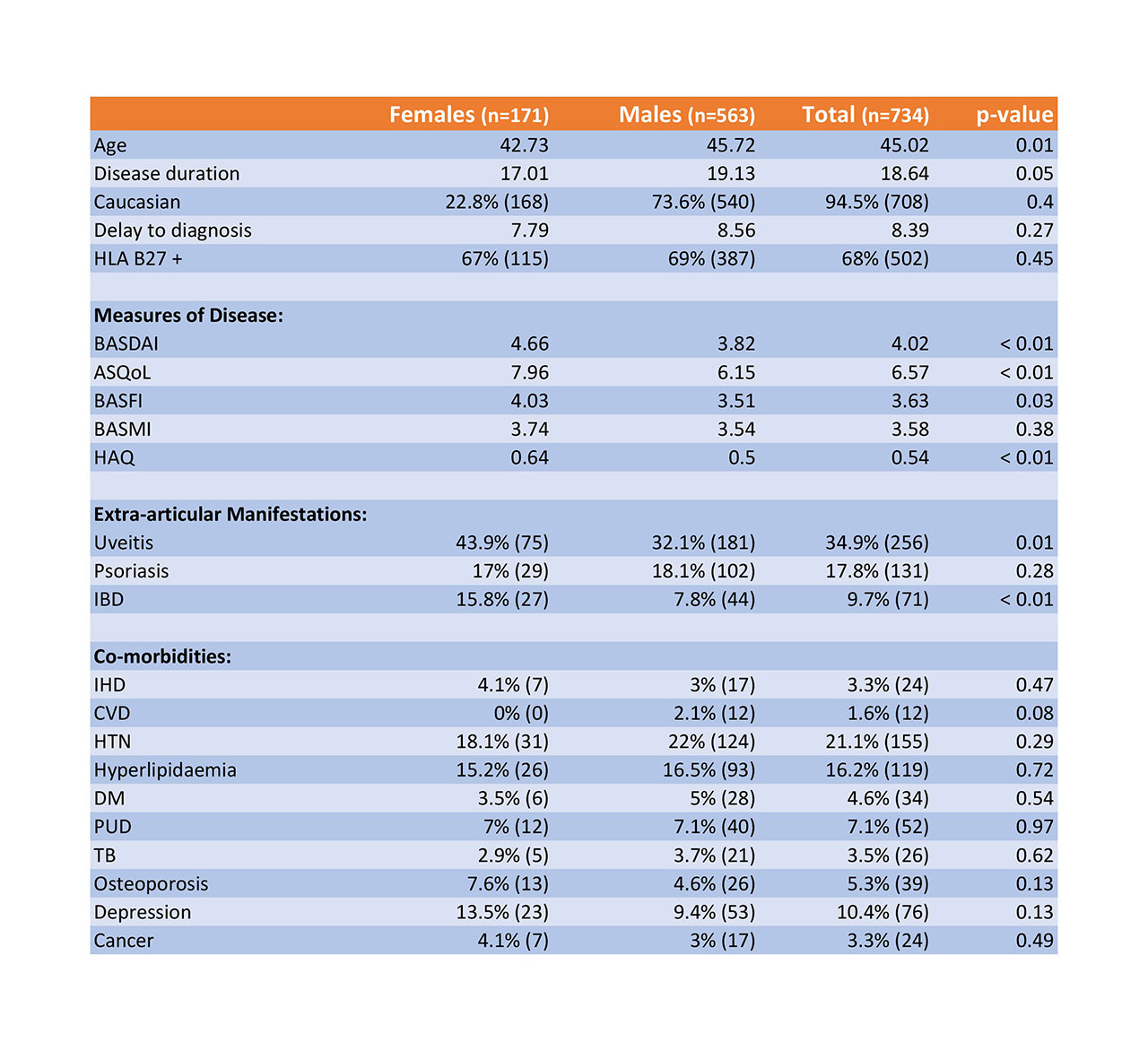Session Information
Session Type: Poster Session (Sunday)
Session Time: 9:00AM-11:00AM
Background/Purpose: Axial Spondyloarthritis(axSpA) is known to have a male predominance. There is little available literature examining affected female patients. Previous studies have included small numbers of females, leading to a lack of detailed analysis of variations between genders. The Ankylosing Spondylitis Registry of Ireland (ASRI) is a source of epidemiological data on patients with axSpA in Ireland. The purpose of this study was to determine if there is a significant difference in disease activity and patterns of disease between genders.
Methods: Analysis of the patient population registered in the ASRI using IBM SPSS version 25. Patients were analyzed on the basis of gender. Mean ASQoL, HAQ, BASDAI, BASFI and BASMI scores were compared. Difference between the two groups was tested for statistical analysis using an independent two tailed t test and a Mann Whitney U test. Further analysis was performed to determine difference in patterns of disease, extra-articular manifestations, medication usage and co-morbidities using a chi-squared test for independence.
Results: Data for 734 patients were reviewed via the registry. The patient population was 14.6% (171) females, 85.4%(563) males, with mean age of 45 years and a mean disease duration of 18 years (means: ASQoL 6.57, HAQ 0.54, BASDAI 4.02, BASFI 3.63, BASMI 3.58). Female patients had higher ASQoL (7.96 vs. 6.15, p < 0.01), HAQ (0.64 vs. 0.50, p < 0.01), BASDAI (4.66 vs. 3.82, p < 0.01), and BASFI scores (4.03 vs. 3.51, p=0.03). No significant difference between BASMI was found between genders (3.74 vs. 3.54, p=0.83) (Figure 1). No significant difference was found in delay to diagnosis (7.79 years in females vs. 8.56 years in males, p=0.05) or HLA B27 positivity (67% vs. 69%, p=0.45). Both genders had comparable incidence of arthritis(39.8% vs. 30.4%, p=0.07) and enthesitis (18.8% vs. 16.7, p=0.74), however females had higher rates of MRI sacroiliitis(48.5% vs. 42.6%, p=0.02) and dactylitis(12.3% vs. 5.2%, p < 0.01). Analysis of medication usage showed no significant difference in use of sDMARD (18.7% vs 19.7%, p=0.7) or biologic exposure (70% vs. 76.8%, p=0.96). A higher proportion of females used NSAIDs (58.5% vs. 48.5%, p=0.02) while a lower proportion of women are currently on biologic therapy (77.7% vs. 87.2%, p=0.01). Regarding extra-articular manifestations, females had higher rates of both inflammatory bowel disease (15.8% vs. 7.8%, p < 0.01) and uveitis (43.9% vs. 32.1%, p=0.01). A range of co-morbidities were also analyzed, however no statistically significant difference in incidence was found (table 1).
Conclusion: There are significant differences between genders in patients with axSpA. This analysis demonstrates that females tend to have higher disease activity, worse levels of function leading to greater impact on their quality of life. Perhaps as a reflection of this, female patients have higher rates of NSAID usage. Females also have higher rates of extra-articular manifestations including inflammatory bowel disease and uveitis. Dedicated research into female patient with axSpA is needed to appropriately address and treat their disease.
To cite this abstract in AMA style:
Maguire S, Fitzgerald G, Sheehy C, O'Shea F. Worse Outcomes for Female Patients with Axial Spondyloarthropathy [abstract]. Arthritis Rheumatol. 2019; 71 (suppl 10). https://acrabstracts.org/abstract/worse-outcomes-for-female-patients-with-axial-spondyloarthropathy/. Accessed .« Back to 2019 ACR/ARP Annual Meeting
ACR Meeting Abstracts - https://acrabstracts.org/abstract/worse-outcomes-for-female-patients-with-axial-spondyloarthropathy/


